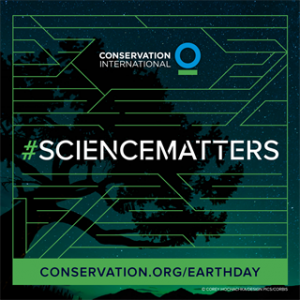AAAS EDITORIAL: Why Earth Optimism?
By Andrew Balmford and Nancy Knowlton
Andrew Balmford is Professor of Conservation Science in the Dept. of Zoology at the University of Cambridge, Cambridge, UK.
Nancy Knowlton is the Sant Chair for Marine Science at the Smithsonian Institution, Washington, DC, USA.
Source: Science, April 21, 2017: Vol. 356, Issue 6335, pp. 225
A focus on conservation in this issue of Science appears on the eve of Earth Day, which is being celebrated by scientists in meetings and public events worldwide. Conservation professionals, who have long condemned attacks on the environment, will gather for Earth Optimism events to highlight conservation achievements. Separately, but simultaneously, marches for science will highlight science’s achievements but also decry that science, scientists, and evidence-based policy-making are under attack. Although distinct in emphasis, these events speak with the same voice.
Science is an intrinsically optimistic endeavor, and many of its achievements have dramatically improved human well-being. This is why support for science remains strong. Nature conservation should be optimistic too (why bother otherwise?), but it often is not. Conservation has been called a crisis discipline, and Earth Day in the United States was born of crisis—the 1969 Santa Barbara oil spill. Since then, doom and gloom have become the norm in conservation messaging, which is why focusing on conservation’s achievements, including those benefiting people as well as the planet, represents an important shift. In the end, support for both science and conservation depends on them delivering positive outcomes.
Environmental scientists’ continuing focus on problems is, however, understandable. Australia’s Great Barrier Reef is undergoing a second consecutive year of bleaching, having suffered unprecedented mass mortality from excessively warm waters last year. Surging rubber prices and land-concession deals have resulted in the loss of over 1.4 million ha of Cambodian forests in just 14 years. At most, 30 vaquitas (endemic porpoises from the Gulf of California) now remain, thanks largely to gill nets set for endangered totoabas, whose swimbladders are prized in Chinese luxury markets. Ignoring such stories for the sake of optimism would be foolish in the extreme.
“…much of conservation depends on the accumulation of small-scale advances…”
Nevertheless, science has helped conservation notch up important successes. Poison baiting of alien rodents that threaten seabird populations has been completed across South Georgia, one of the most important seabird islands on Earth. Researchers have announced progress toward a vaccine to protect remaining Tasmanian devils against lethal devil facial tumor disease. Release of scimitar-horned oryx—declared extinct in the wild in 2000—has brought to 35 the number that are now free-ranging in Chad, including the first wild birth this century. Although some of these achievements may seem limited in scope, much of conservation depends on the accumulation of small-scale advances across the planet.
Moreover, there are larger-scale successes to celebrate too. In Brazil, the rate of Amazon deforestation is down to about one-third of its 2004 peak. Marine Protected Areas now cover over 5% of the oceans—up from around 1% a decade ago. Threats posed by climate change to species and ecosystems are being reduced by increases in solar and wind power, as exemplified by large Chinese investments in renewable energy, set to exceed $300 billion by 2020. These wins are partial, equivocal, patchy, and reversible; for example, Amazon deforestation is increasing again. Much more change in how we interact with the planet is needed. Identifying and learning from successes enables replication and scaling-up, which buys time while harder problems are tackled.
Another key ingredient for major change is hope. After all, Martin Luther King Jr. famously said, “I have a dream,” not “I have a problem.” Studies show that presenting people with huge problems without solutions leads to disengagement. Without examples of conservation succeeding, hopelessness could itself emerge as a driver of extinction. Directing more effort toward identifying, understanding, and celebrating conservation success, drawing on insights from the natural and social sciences, is key to securing the knowledge, time, and public engagement needed to reverse the tide of loss.
See also: www.FrackCheckWV.net

